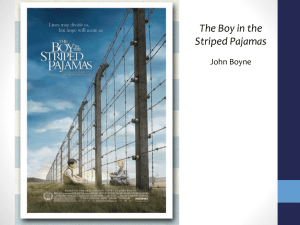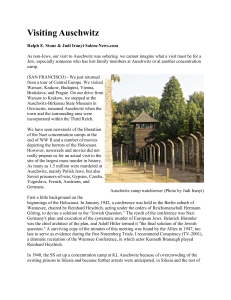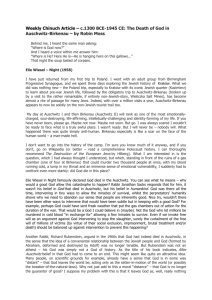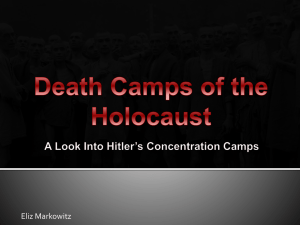Auschwitz I: A Virtual Tour Assignment
advertisement
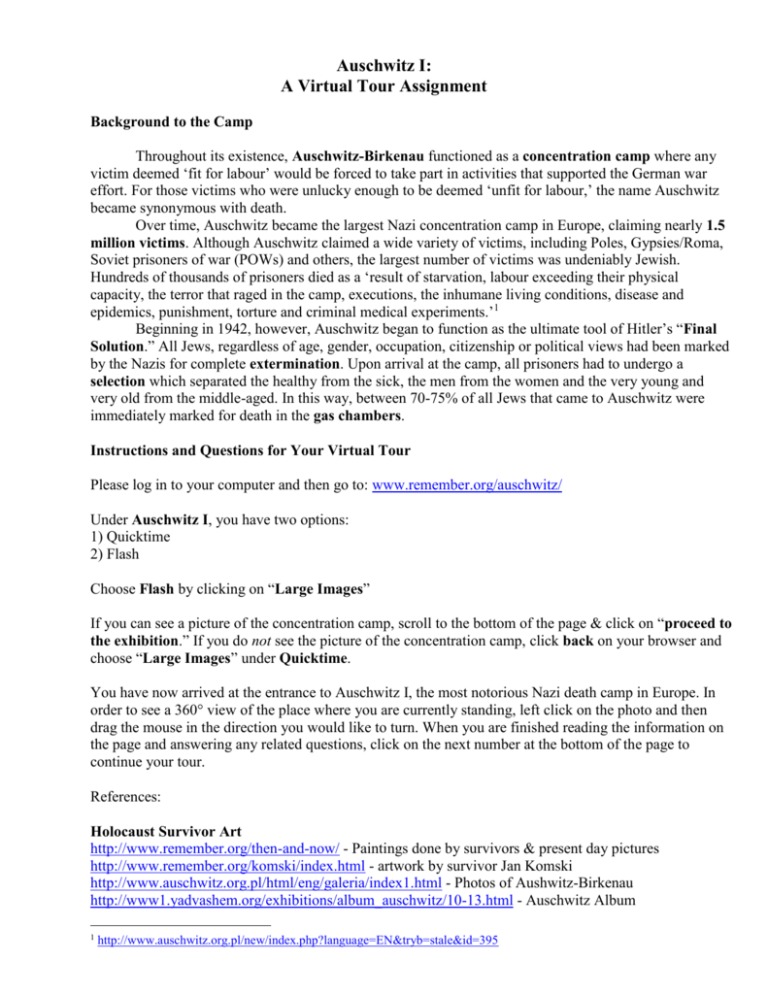
Auschwitz I: A Virtual Tour Assignment Background to the Camp Throughout its existence, Auschwitz-Birkenau functioned as a concentration camp where any victim deemed ‘fit for labour’ would be forced to take part in activities that supported the German war effort. For those victims who were unlucky enough to be deemed ‘unfit for labour,’ the name Auschwitz became synonymous with death. Over time, Auschwitz became the largest Nazi concentration camp in Europe, claiming nearly 1.5 million victims. Although Auschwitz claimed a wide variety of victims, including Poles, Gypsies/Roma, Soviet prisoners of war (POWs) and others, the largest number of victims was undeniably Jewish. Hundreds of thousands of prisoners died as a ‘result of starvation, labour exceeding their physical capacity, the terror that raged in the camp, executions, the inhumane living conditions, disease and epidemics, punishment, torture and criminal medical experiments.’1 Beginning in 1942, however, Auschwitz began to function as the ultimate tool of Hitler’s “Final Solution.” All Jews, regardless of age, gender, occupation, citizenship or political views had been marked by the Nazis for complete extermination. Upon arrival at the camp, all prisoners had to undergo a selection which separated the healthy from the sick, the men from the women and the very young and very old from the middle-aged. In this way, between 70-75% of all Jews that came to Auschwitz were immediately marked for death in the gas chambers. Instructions and Questions for Your Virtual Tour Please log in to your computer and then go to: www.remember.org/auschwitz/ Under Auschwitz I, you have two options: 1) Quicktime 2) Flash Choose Flash by clicking on “Large Images” If you can see a picture of the concentration camp, scroll to the bottom of the page & click on “proceed to the exhibition.” If you do not see the picture of the concentration camp, click back on your browser and choose “Large Images” under Quicktime. You have now arrived at the entrance to Auschwitz I, the most notorious Nazi death camp in Europe. In order to see a 360° view of the place where you are currently standing, left click on the photo and then drag the mouse in the direction you would like to turn. When you are finished reading the information on the page and answering any related questions, click on the next number at the bottom of the page to continue your tour. References: Holocaust Survivor Art http://www.remember.org/then-and-now/ - Paintings done by survivors & present day pictures http://www.remember.org/komski/index.html - artwork by survivor Jan Komski http://www.auschwitz.org.pl/html/eng/galeria/index1.html - Photos of Aushwitz-Birkenau http://www1.yadvashem.org/exhibitions/album_auschwitz/10-13.html - Auschwitz Album 1 http://www.auschwitz.org.pl/new/index.php?language=EN&tryb=stale&id=395 /30 Auschwitz I Virtual Tour Question Sheet Auschwitz I Entrance (exterior) 1. What does “Arbeit Macht Frei” mean? (1 mark) 2. Why might this phrase be considered ironic or as a betrayal to the people who entered the camp? (1 mark) Auschwitz I Appelplatz (Roll Call Square) 3. Describe the conditions of appel (roll call) and how it affected prisoners. (4 marks) The Waiting Room to the Gas* - The Krankenbrau (Prisoner’s Hospital) 4. Why was it dangerous for a prisoner of Auschwitz to admit that they were sick or injured enough to need medical attention? (2 marks) Block 11 5. Describe the purposes of Block 10 and Block 11 buildings and the courtyard between the two. (4 marks) Block 11: Standing Cells 6. What is a standing cell? (1 mark) Edek and Mala 7. Describe some of the ways in which Edek and Mala resisted the Nazi regime while prisoners of Auschwitz. (3 marks) The Gas Chamber at Krematorium I 8. What was the name of the gas used in Auschwitz and how did it work? (2 marks) You are now finished touring Auschwitz I. Please continue your tour to Birkenau by clicking in the ‘Birkenau’ at the bottom of the page. The Unloading Ramp 9. Why is it ironic that physicians are the men that made the selections upon prisoner arrival at the camps? (2 mark) Men’s Barracks & Women’s Barracks 10. Describe the conditions of the men’s and women’s barracks. (3 marks) Latrine in the Women’s Camp 11. Think about the conditions of the barracks and the latrines. Why do you think the SS were able to treat Jewish prisoners so cruelly during WWII? (2 marks) Krematoria II (interior) 12. Why did the Nazis blow up the krematoriums as the war was ending? (1 mark) The Rear of Birkenau: The Final Moments 13. Up until the last possible moment, Nazis in charge of death camps like Birkenau kept up an elaborate charade of deception. Why do you think that they did this? What purpose did it serve (and for whom)? (2 marks) The Sauna & “Kanada” 14. What is the Canadian connection to Birkenau? (hint: Kanada = Canada) (2 mark) …and that’s the end of our tour. * If there is class time remaining or you are interested in seeing how Jewish victims of the Holocaust have personally recorded their experiences in an artistic manner, please visit the websites listed on the first page of this handout. Auschwitz I: A Virtual Tour Assignment - Answer Sheet Auschwitz I 1. What does “Arbeit Macht Frei” mean? Arbeit Macht Frei means roughly, “Work Will Make You Free” over the entrance. This is where prisoners marched to and from slave labour, and was the front gates to the concentration camp. 2. Why might this phrase be considered ironic or as a betrayal to the people who entered the camp? Because the only way anyone would be free from the camps would be either if they were rescued by allied troops or if they were killed and cremated. 3. Describe the conditions of appel (roll call) and how it affected prisoners. These were conditions where prisoners stood at attention in ranks in the morning and in the evening. They were forced to stand here with no exceptions for weather. When the prisoner count was short they stood until it was correct, sometimes all night. This, while enduring a conscious program of psychological dehumanization and physical degradation consisting of frequent beatings, insufficient food, primitive sanitary conditions promoting disease, little or no medical attention, and long hours of brutal slave labor with constant harassment and beatings. Prisoners were assembled here and in both directions left and right, in the morning and evening. It is one of the places where “selections” were made sending prisoners back to slave labor or to their deaths. Each morning and evening all prisoners had to be accounted for, even those who had perished. 4. Why was it dangerous for a prisoner of Auschwitz to admit that they were sick or injured enough to need medical attention? When prisoners were too ill or weak they made their way or were taken to the camp "hospital". More often then not prisoners who came to this place either died here of "natural causes" such as exhaustion, typhus, dysentery, were given a phenol injection in the heart, or were taken to the gas. 5. Describe the purposes of Block 10 and Block 11 buildings and the courtyard between the two. Block 10 - where Dr. Carl Clauberg conducted sterilization and other experiments on women prisoners; Block 10, two posts in the concrete walkway. On them were hooks with which to hang prisoners by their wrists bound behind their backs, thus dislocating shoulder joints. Block 11 – a courtyard where prisoners were shot in the head against the black wall at the opposite end; Block 11 was strictly isolated from the rest of the camp. "Trials of [the poison gas, hydrogen cyanide] for killing people were begun in the summer of 1941, in the basement of Block 11. 6. What is a standing cell? Standing cells were cells where prisoners were made to crawl in through small doors on the floor. Once inside it was impossible to sit down. Sometimes 4-5 people were placed in here overnight with no toilet facilities. Moreover they had to work in daytime like anyone else, only to return back after the evening roll call. 7. Describe some of the ways in which Edek and Mala resisted the Nazi regime while prisoners of Auschwitz. One famous story in Auschwitz lore involves two people who fell in love in the camp. Mala spoke fluent German, Mala was a prisoner-translator for the SS, and thereby given special treatment. At great risk she smuggled food, messages, and other items to her fellow prisoners. Edek inscribed their names on several cells. He was hanged; Mala, about to be hanged, slashed her wrists on the gallows in a final act of defiance. 8. What was the name of the gas used in Auschwitz and how did it work? The Gas was called “Zyklon B” and was used in Germany before and during the war for disinfection and pest extermination in ships, buildings and machinery. In Auschwitz it was used exclusively for sanitation and pest control until the end August of 1941. From that time it was used as an agent of mass annihilation, first experimentally (on Russian POW's) and then routinely on the Jews. Birkenau 9. Why is it ironic that physicians are the men that made the selections upon prisoner arrival at the camps? Physicians are meant to help people. These German physicians in the camp identifed people for death. Immediately after disembarking from the trains, the Jews, and others, were made to line up in two columns: women and children in one, and men in the other. Next, SS physicians separated the strong and healthy people from the elderly, the sick, pregnant women, and children. Those regarded as fit for labor were sent to the camp. The others, usually 70-75% of each transport, were sent to their deaths in the gas chambers. 10. Describe the conditions of the men’s and women’s barracks. Men’s barracks - In three tiered bunks, or hutches, there were at times 9–12 persons on each level. Very cramped space; the three deck hutches were originally intended to hold 15 prisoners, the total population about 400, but some quarantine barracks held as many as 2,000 prisoners each. Women’s barracks - Each tier was to have three straw mattresses, one for each prisoner. In reality, two or more slept on each mattress, 6 to 9 prisoners on each tier. 11. Think about the conditions of the barracks and the latrines. Why do you think the SS were able to treat Jewish prisoners so cruelly during WWII? The SS saw the prisoners as less than human, dehumanized, even not human, merely insects (VERMIN). There was also a dehumanization of the SS accomplished by an insurmountable arrogance. The prisoners were dehumanized by brutality, and the SS by ideology. 12. Why did the Nazis blow up the krematoriums as the war was ending? The Nazis tried to hide their crimes, so they blew the Krematorium up, and also Krems III and V, ample proof they were well aware they had committed war crimes, crimes against humanity, and genocide. 13. Up until the last possible moment, Nazis in charge of death camps like Birkenau kept up an elaborate charade of deception. Why do you think that they did this? What purpose did it serve (and for whom)? This allowed them to provide enough of a deception to get everyone they needed who were not physically able to work to be gassed. This is where people just off the trains were brought and told they were about to receive a disinfecting shower, and afterward... work. They did not have enough troops to quell a revolt once the Jewish people got off the train. 14. What is the Canadian connection to Birkenau? (hint: Kanada = Canada) This is where possessions were taken from prisoners were stored in barrack warehouses, named in camp jargon, “Kanada”. Jews were told to bring their essential belongings on the transport to "Relocation". Immediately upon unloading, these were taken and sorted in these warehouses because it was a place of abundance.; Canadians did the same thing to the Japanese Canadians during WWII



